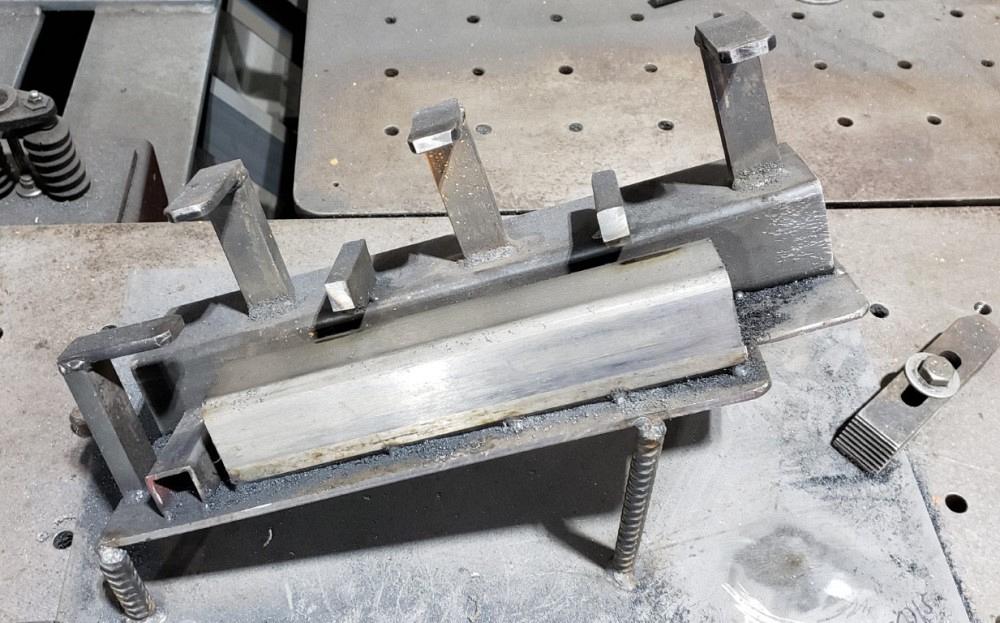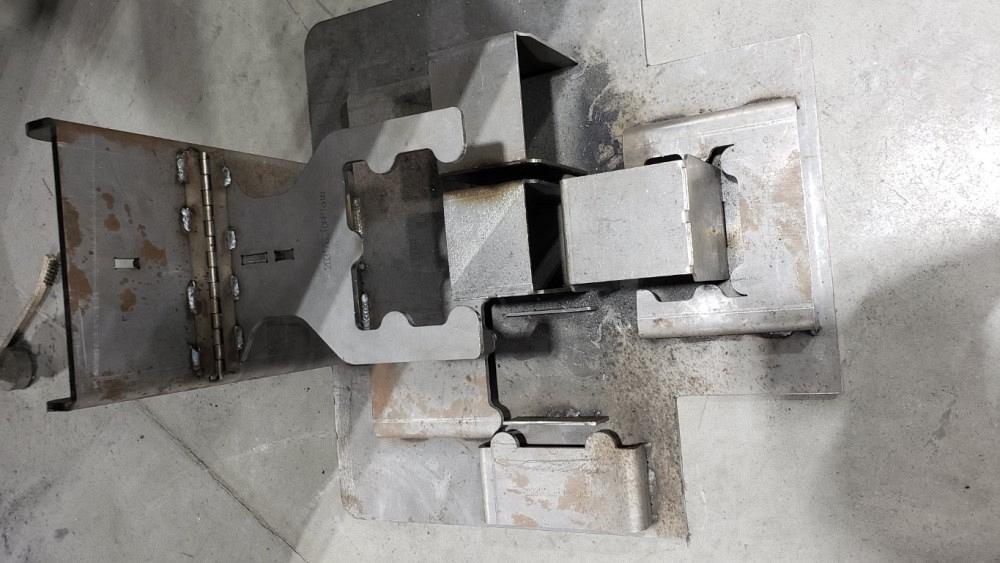- FMA
- The Fabricator
- FABTECH
- Canadian Metalworking
Categories
- Additive Manufacturing
- Aluminum Welding
- Arc Welding
- Assembly and Joining
- Automation and Robotics
- Bending and Forming
- Consumables
- Cutting and Weld Prep
- Electric Vehicles
- En Español
- Finishing
- Hydroforming
- Laser Cutting
- Laser Welding
- Machining
- Manufacturing Software
- Materials Handling
- Metals/Materials
- Oxyfuel Cutting
- Plasma Cutting
- Power Tools
- Punching and Other Holemaking
- Roll Forming
- Safety
- Sawing
- Shearing
- Shop Management
- Testing and Measuring
- Tube and Pipe Fabrication
- Tube and Pipe Production
- Waterjet Cutting
Industry Directory
Webcasts
Podcasts
FAB 40
Advertise
Subscribe
Account Login
Search
Welding robot saves the day
Automating certain repetitive welds can be a lifesaver for small job shops
- By Nick Martin
- September 26, 2020

North Carolina job shop Barnes MetalCrafters doesn’t often need to use its welding robot. But when a project, no matter how few and far between, calls for repetitive welds, the automated process can be a lifesaver for the small metal fabrication business. Getty Images
We have one employee at our shop that comes to work every day, has never missed a day, rarely messes up, and is never hungover. Seems too good to be true. Only problem is that this employee doesn’t work every day. That’s because this employee is a welding robot. If the robot did work every day, that would mean we would be much busier. And, contrary to many beliefs, it would mean our shop would need one or two more employees.
People always ask why we don’t use it more often. It takes a certain type of job to put on our welding robot. Ours is a 6-axis robot with MIG welding capability. Pretty straightforward stuff, but some of the jobs we get are small orders that we will most likely never see again. Tons of parts have come through the shop since we’ve had the robot that would have been perfect for it. But why take the time to make a jig and program it unless the job is for a large quantity of parts? It’s not feasible for a job we may never see again.
We’ve looked into offline programming for the welding robot, but we couldn’t justify the cost versus the benefit. Would we use it more if we could program it faster? Probably, if we had ready-made jigs and the resources to make it happen. We are a small shop. Every employee at Barnes MetalCrafters wears multiple hats and often does odd jobs at any given time. If we had a few more people in the technical robot programming department, it would be an easy move. For investment purposes, there are a few other routes we could and need to take. Our technology may be a bit outdated, but it may not be worth the upgrade if we don’t put it to work as much as we should.
I will say when we have jobs for our robot, it really puts the work out the door. The guys on the floor really like the fact that it takes away the simple, repetitive projects. That is what it is designed to do. Once the robot is programmed and set up, it is a pretty simple process. Watch your gas levels, make sure the tip stays clean, and load the parts properly in the jig.
Recently our welding robot co-worker was put to the test. We had a very large job come through the shop that had to be turned around in a very timely manner. In order to meet the deadlines, we had to outsource some tubing laser work. The job, in a nutshell, was a short section of square tubing with four countersunk holes that would be welded on top of a formed channel. Multiply that process with a couple different odd shapes by several thousand and you have the basic gist of the entire job.
On my wish list is something I’ve always had a fascination with: a laser tube cutting machine. I could see us using one in the future. For the time being, though, we have to let others have the fun. While we were waiting on the laser-cut square tubing, we went to work laser cutting the sheet metal to be formed into channels. To knock out the job, we ended up cutting some of the sheets on our new fiber laser and some on the older CO2 laser. We don’t use the older laser as much anymore, but like any old car or machine, you need to run it and keep it moving.
While the shop floor was making parts, I was designing jigs for the welding robot in Autodesk Inventor. I wanted to get the jigs about as close as possible and as fast as possible so I could get drawings and cut sheets out to the floor. My jig design started out with the part we had to make the most. I designed the jig using key and slots to locate folded channels that would sit inside the part channels we were to make. They would be held off the base plate a few inches so weld splatter would have a place to go. Did I mention that these jigs were not perfect? That's because we needed them done really quick. We would fabricate the remainder of the jig on- the-fly to make the parts fit nice and snug.
Robots appreciate nice, accurate parts that are located in the same place every time. We like to use the gravity technique as often as possible, keeping the clamps to a minimum. Another good thing about these jigs and parts was that most of the welds were straight and horizontal. Those were relatively easy to program without a lot of tricky moves. The downside to rushing these parts through the shop was that we couldn’t run all of them on the robot, but least we would get to tackle the high-quantity parts to take a load off all the welders.
Before we could weld the parts on the robot, all the holes that were cut on the tubing laser had to be countersunk. We do not have any automation for this process, so we had a couple drill presses set up to handle the task. Now allow the misery to soon settle in for the operators. One of our laser operators, Tyler Fyock, soon became the drill press man. We all stopped by his station occasionally and asked him how things were going. The usual responses were not the most G-rated, but my favorite was when he sarcastically said that he was “just waiting to die.” Not all jobs come in fun packages. I believe Tyler no longer refers to it as a drill press. It is now the “countersink machine.”
When the robot was finally ready to work its magic, we had piles of parts ready to throw at it. We were running three of the four welding stations simultaneously with one man. The cycle times were just long enough that the operator could walk back and forth between stations and manage to keep the robot moving nearly 100% of the time. It was a pretty cool sight to see.
When we got to the short rows on this job, everyone was showing their fatigue and ready to move on to the next task. It does get exhausting when you are not used to running the same thing day in and day out. We are a job shop so there are breaks between jobs. I don’t think I would have it any other way.
Our employees made it through. I believe a couple vacation days were taken to get away from welding and countersinking. What can you do? But, hey, we did have one employee that never showed any signs of slowing down. The welding robot was right there through the thick of it. Maybe I’ll leave some beer on the table for after hours.
subscribe now

The Fabricator is North America's leading magazine for the metal forming and fabricating industry. The magazine delivers the news, technical articles, and case histories that enable fabricators to do their jobs more efficiently. The Fabricator has served the industry since 1970.
start your free subscriptionAbout the Author

Nick Martin
2121 Industrial Park Drive SE
Wilson, NC, 27893
252-291-0925
- Stay connected from anywhere

Easily access valuable industry resources now with full access to the digital edition of The Fabricator.

Easily access valuable industry resources now with full access to the digital edition of The Welder.

Easily access valuable industry resources now with full access to the digital edition of The Tube and Pipe Journal.
- Podcasting
- Podcast:
- The Fabricator Podcast
- Published:
- 04/16/2024
- Running Time:
- 63:29
In this episode of The Fabricator Podcast, Caleb Chamberlain, co-founder and CEO of OSH Cut, discusses his company’s...
- Trending Articles
AI, machine learning, and the future of metal fabrication

Employee ownership: The best way to ensure engagement

Steel industry reacts to Nucor’s new weekly published HRC price

Dynamic Metal blossoms with each passing year

Metal fabrication management: A guide for new supervisors

- Industry Events
16th Annual Safety Conference
- April 30 - May 1, 2024
- Elgin,
Pipe and Tube Conference
- May 21 - 22, 2024
- Omaha, NE
World-Class Roll Forming Workshop
- June 5 - 6, 2024
- Louisville, KY
Advanced Laser Application Workshop
- June 25 - 27, 2024
- Novi, MI




























